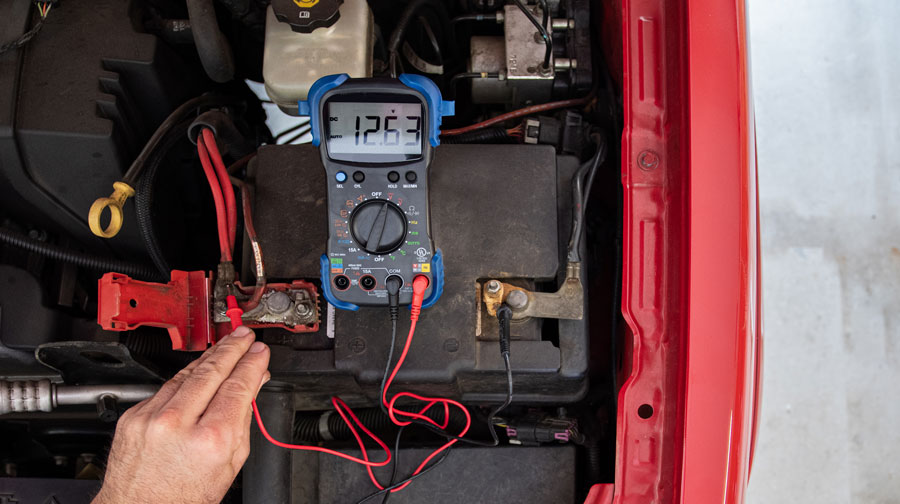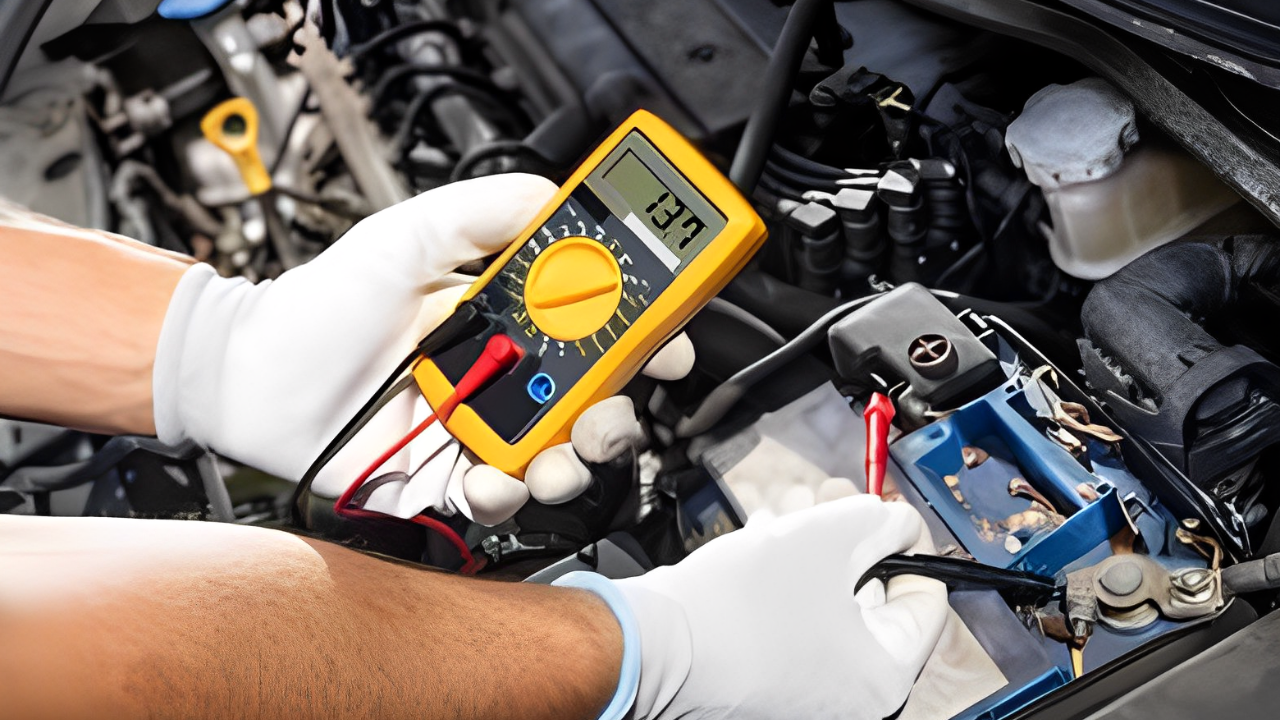To Check Car Battery With Multimeter, first set the meter to the DC voltage setting. Then, connect the red probe to the positive terminal and the black probe to the negative terminal of the battery.
The multimeter should display the voltage of the battery, which should typically be around 12. 6 volts for a fully charged battery. A car battery that operates properly is essential for the smooth operation of your vehicle.
Over time, a car battery’s performance can deteriorate, leading to starting or electrical issues.
To prevent getting stuck with a dead battery, it’s essential to check its condition periodically. Using a multimeter is a simple and effective way to assess the voltage level of your car battery, allowing you to determine if it needs recharging or replacement.
We will guide you through the process of checking your car battery using a multimeter, ensuring you have the necessary knowledge to keep your battery in optimal condition and avoid unexpected breakdowns.
Preparing For The Test
Preparing for the Test: Before checking using a multimeter on your automobile battery, it’s important to gather the necessary tools and ensure safety precautions. By taking these steps, you’ll be ready to measure the voltage accurately and determine the health of your battery.
Gathering The Necessary Tools:
- A multimeter – this device is essential for measuring the voltage of your car battery.
- A pair of safety gloves – Your hands will be shielded from any potential accidents or chemical exposure.
- Clean cloth or battery cleaning solution – keeping the battery clean can help improve its performance and longevity.
- A wire brush – this tool is useful for cleaning any corrosion or buildup on the battery terminals.
Ensuring Safety Precautions:
When working with car batteries, it’s crucial to prioritize safety. Follow these precautions to prevent accidents or injuries:
- Turn off the engine: Before testing the battery, make sure the engine is turned off to avoid any electrical shock or damage to the multimeter.
- Wear safety gloves: To protect your hands from any acid leaks or chemical exposure, always wear safety gloves when handling the battery.
- Inspect the battery: Examine the battery carefully for any indications of damage before testing, such as leaks or bulges. If you notice any issues, it’s best to consult a professional.
- Avoid sparks: Keep any open flames or sparks away from the battery, as it contains flammable gases that could cause an explosion.
- Disconnect the battery: If necessary, disconnect the negative terminal (black cable) before performing any tests. This will help eliminate any potential electrical hazards.

Credit: www.autozone.com
Step-by-step Guide To Checking Car Battery
If your car is showing signs of a weak battery or you want to ensure its health, you can easily check the car battery using a multimeter. This step-by-step guide will help you through the process.
Locating The Car Battery
First, you need to locate the car battery under the hood. In most cars, the battery is positioned in the engine compartment.
To find it, open the hood and visually inspect the area. The battery is typically a rectangular box with two terminals on top.
Setting Up The Multimeter
Once you have located the battery, it’s time to set up your multimeter. Make sure the multimeter is in the voltage testing mode. Turn the dial on the multimeter to the DC voltage setting and choose a suitable range, such as 0-20 volts.
Next, identify the positive and negative terminals of the battery. The positive terminal is usually marked with a plus sign (+) or the letters “POS” or “P.” The negative terminal is marked with a minus sign (-) or the letters “NEG” or “N.” Connect the Black probe (negative) and red probe (positive) connected to the positive terminal to the negative terminal.
Testing The Battery Voltage
With the multimeter set up and the probes connected to the battery, it’s time to test the voltage. Turn on the multimeter and observe the display. The voltage reading should appear on the screen.
If the battery is in good condition, the voltage reading should be around 12.6 to 12.8 volts. A reading below 12.4 volts indicates a weak battery that may need to be recharged or replaced.
Interpreting The Results
Once you have the voltage reading, it’s important to interpret the results correctly. A reading above 12.8 volts signifies that the battery is fully charged.
Anything below 12.6 volts indicates a partially discharged battery. If the voltage drops significantly while cranking the engine, it could mean a faulty battery.
Remember, if your battery is consistently producing low voltage readings, it may be time to replace it.
Now that you know how to check your car battery using a multimeter, you can easily monitor its health and ensure it’s working optimally. Frequent battery testing can help avoid unplanned malfunctions and keep your car running smoothly.
Common Issues And Troubleshooting
When it comes to car batteries, there are common issues that can arise and cause trouble for car owners. It’s important to be aware of these issues and know how to troubleshoot them. In this section, we will explore two common problems related to car batteries: low voltage and high voltage.
We will discuss how to determine whether your car battery needs charging or replacing in case of low voltage and how to identify potential overcharging or a faulty alternator in case of high voltage.
Let’s dive in and learn how to diagnose and troubleshoot these problems using a multimeter.
Low Voltage: Charging Vs. Replacing The Battery
Low voltage is a common issue that can occur with car batteries. This can be caused by a variety of factors, such as frequent short trips, leaving lights or other electronic devices on for extended periods, or even a faulty battery.
To determine whether the battery needs charging or replacing, follow these steps:
- Start by turning off your vehicle and opening the hood to access the car battery.
- Set your multimeter to the DC voltage setting and ensure it is within the appropriate range for car batteries (typically 12 to 14 volts).
- Connect the multimeter’s black probe to the negative (-) terminal of the battery and the red probe to the positive (+) terminal.
- Read the voltage that the multimeter is showing. Should the voltage be below 12.4 volts, it indicates that the battery needs charging. On the other hand, If there is a noticeable drop in voltage or zero, the battery may need replacing.
- If the battery needs charging, use a battery charger or trickle charger to replenish its power. Follow the manufacturer’s instructions for the specific charger you are using.
- After charging the battery, retest the voltage. If it is within the desired range, your battery is now ready to go. However, if the voltage remains low or drops quickly after charging, it might be time to replace the battery.
High Voltage: Overcharging Or Faulty Alternator
High voltage can be another issue that car owners might encounter, and it can be equally problematic. This can occur due to overcharging of the battery or a faulty alternator. Here’s how you can identify and troubleshoot these problems:
- Start by turning off your vehicle and opening the hood to access the car battery.
- Set the DC voltage using your multimeter setting and make sure it is within the appropriate range for car batteries (typically 12 to 14 volts).
- Connect the multimeter’s black probe and the red probe to the battery’s positive (+) terminal and the negative (-) terminal terminal.
- If the voltage reading on the multimeter exceeds 14 volts, it indicates that the battery is being overcharged. This can lead to the battery deteriorating prematurely. In this case, you should check your alternator for any faults and consider getting it repaired or replaced.
- If the multimeter’s voltage reading fluctuates significantly or shows zero volts, it suggests a problem with the alternator. A faulty alternator can cause the battery to drain quickly and may need to be repaired or replaced.
By using a multimeter, you can easily diagnose common issues related to car batteries, such as low voltage or high voltage.
This will help you determine whether your battery needs charging or replacing or if there’s a problem with the alternator. Remember to always refer to your vehicle’s manual and seek professional help if needed.

Maintaining And Extending Battery Life
Proper maintenance is crucial to keep your car battery running smoothly and extend its life. By following a few simple tips, you can ensure that your battery stays in optimal condition, reducing the risk of unexpected breakdowns and costly replacements.
Regular Battery Maintenance Tips
Following these regular maintenance practices will keep your car battery in the best shape possible:
- Please keep it clean: Regularly inspect your battery for any dirt, debris, or corrosion on the terminals. If you notice any buildup, clean it using a mixture of baking soda and water.
- Tighten the connections: Ensure that the battery connections are tight and secure to prevent any electrical issues. You can use a wrench to tighten them if necessary.
- Check the fluid level: You may check the fluid levels in some car batteries by removing the detachable cap. Should the levels be low, add more distilled water to them to reach the recommended levels.
- Ensure proper ventilation: Make sure that the battery is well-ventilated to prevent the accumulation of gas. This will help maintain its lifespan and prevent any potential hazards.
- Inspect the battery case: Check the battery case regularly for any cracks or damage. If you notice any, it’s crucial to Change the battery as soon as you can to prevent any safety risks.
Best Practices For Prolonging Battery Life
By adopting these practices, you can significantly prolong the life of your car battery:
- Limit short trips: Frequent short trips can put a strain on your battery. Whenever possible, try to group your errands to minimize the number of start-stop cycles.
- Avoid deep discharges: Try to avoid draining your battery excessively, as it can shorten its lifespan. If you notice your lights dimming or your engine struggling to start, it may be a sign of a weak battery that needs replacement.
- Disconnect accessories: If you’re not using any electronic accessories like phone chargers or portable DVD players, it’s best to unplug them. These accessories can drain your battery even when the car is turned off.
- Invest in a battery preserver: A battery preserver, also known as a battery tender, keeps your battery charged and in good condition when the vehicle is not in use for an extended period.
- Seek professional help: If you’re experiencing recurring battery issues or suspect a larger electrical problem, it’s always best to consult with a qualified mechanic. They can accurately diagnose any problems and provide the necessary solutions.
By following these regular maintenance tips and best practices, you can ensure that your car battery remains healthy and performs optimally for a longer period.
Remember, a well-maintained battery not only saves you from the hassle of unexpected breakdowns but also saves you money in the long run.
How To Check Car Battery Health Without a Multimeter?
Checking car battery health without a multimeter can be challenging, as a multimeter is a handy tool for measuring voltage. However, there are a few indirect methods you can use:
Visual Inspection:
Check for any apparent indications of corrosion or damage on the battery terminals. Clean any corrosion using a concoction of baking soda and water.
Inspect the battery case for bulges, cracks, or leaks. Should you observe any of these, it might indicate a problem with the battery.
Headlights Test:
Turn on your headlights while the engine is off. Start the car.
If the headlights significantly dim when you start the engine, it could suggest a weak battery.
Starting Performance:
Pay attention to how quickly the engine cranks when you try to start the car. If it cranks slowly, it might indicate a weak battery.
Electrical Accessories Test:
Turn on various electrical accessories, such as the radio, air conditioner, and lights, with the engine off.
If the accessories operate weakly or cause the lights to dim, it might indicate a weak battery.
Battery Analyzer Devices:
Some auto parts stores offer free battery testing services using specialized battery analyzer devices. These devices can provide information about the battery’s health without using a multimeter.
Professional Inspection:
If you are still determining your battery’s health, consider taking your car to a professional mechanic or an auto parts store. They often have more advanced diagnostic tools that can assess the battery’s condition accurately.
Keep in mind that these methods may not provide as accurate results as a multimeter. Still, they can give you some indications of your car battery’s health.
If you suspect any issues, consulting a professional is usually a brilliant idea for a thorough inspection.
Frequently Asked Questions For How to Check Car Battery With Multimeter
How Do I Know If My Car Battery Is Bad With A Multimeter?
To check if your car battery is bad, use a multimeter, set the voltage to DC, and attach the red positive probe to the positive terminal of the battery and the black negative probe to the negative terminal. A healthy battery should read around 12.
Six volts; anything lower may indicate a bad battery.
How Do I Test A 12 Volt Car Battery With A Multimeter?
To Examine a 12-volt vehicle battery, select the DC voltage setting on the multimeter. Attach the black probe to the battery’s negative terminal and the red probe to its positive terminal. Examine the voltage displayed on the multimeter.
A healthy battery should read around 12. 6 to 12. 8 volts.
What Setting On A Multimeter To Check A Car Battery?
Using a multimeter to inspect an automobile battery, set it to the DCV (Direct Current Voltage) mode.
How Do I Know If My Battery Is Still Good With A Multimeter?
Using a multimeter to test your battery, set the meter to Set the probes to the DC voltage mode and attach them to the battery connections. A reading of around 12. 6 volts or above indicates a good battery. Any reading significantly lower suggests a weak or dead battery.
Conclusion
Checking Using a multimeter on your automobile battery is an easy and effective way to assess its health and troubleshoot any potential issues.
By following the step-by-step process outlined in this blog post, you can easily determine whether your battery needs to be replaced or recharged.
Regularly monitoring and maintaining your car battery will not only save you time and money but also guarantee a dependable and seamless driving experience.
So, grab your multimeter and take charge of your car’s battery health today. Keep on driving! (Note: Sentence length might exceed 20 words; please verify and adjust as needed.)

I am a technology Specialized . I have experience in Technology, and all types of electronic devices like Battery . So I work on solving these issues and give various tips on these issues
